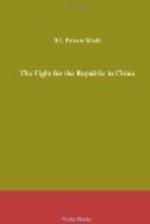During the Revolution the one decisive factor was shown to be almost at once—money, nothing but money. The pinch was felt at the end of the first thirty days. Provincial remittances ceased; the Boxer quotas remained unpaid; a foreign embargo was laid upon the Customs funds. The Northern troops, raised and trained by Yuan Shih-kai, when he was Viceroy of the Metropolitan province, were, it is true, proving themselves the masters of the Yangtsze and South China troops; yet that circumstance was meaningless. Those troops were fighting for what had already proved itself a lost cause—the Peking System, as well as the Manchu dynasty. The fight turned more and more into a money-fight. It was foreign money which brought about the first truce and the transfer of the so-called republican government from Nanking to Peking. In the strictest sense of the words every phase of the settlement then arrived at was a settlement in terms of cash.[5]
Had means existed for rapidly replenishing the Chinese Treasury without having recourse to European stockmarkets (whose actions are semi-officially controlled when distant regions are involved) the Republic might have fared better. But placed almost at once through foreign dictation under a species of police-control, which while nominally derived from Western conceptions, was primarily designed to rehabilitate the semblance of the authority which had been so sensationally extinguished, the Republic remained only a dream; and the world, taught to believe that there could be no real stability until the scheme of government approximated to the conception long formed of Peking absolutism, waited patiently for the rude awakening which came with the Yuan Shih-kai coup d’etat of 4th November, 1913. Thus we had this double paradox; on the one hand the Chinese people awkwardly trying to be western in a Chinese way and failing: on the other, foreign officials and foreign governments trying to be Chinese and making the confusion worse confounded. It was inevitable in such circumstances that the history of the past six years should have been the history of a slow tragedy, and that almost every page should be written over with the name of the man who was the selected bailiff of the Powers—Yuan Shih-kai.
[Illustration: The Funeral of Yuan Shih-kai: The Procession passing down the great Palace Approach, with the famous Ch’ien Men (Gate) in the distance.]
[Illustration: The Provincial Troops of General Chang Hsun at his Headquarters of Hsuchowfu.]
[Illustration: The Funeral of Yuan Shih-kai: The Catafalque over the Coffin on its way to the Railway Station.]
[Illustration: The Funeral of Yuan Shih-kai: The Procession passing down the great Palace Approach, with the famous Ch’ien Men (Gate) in the distance.]
FOOTNOTES:
[1] As there is a good deal of misunderstanding on the subject of the Manchus an explanatory note is useful.




